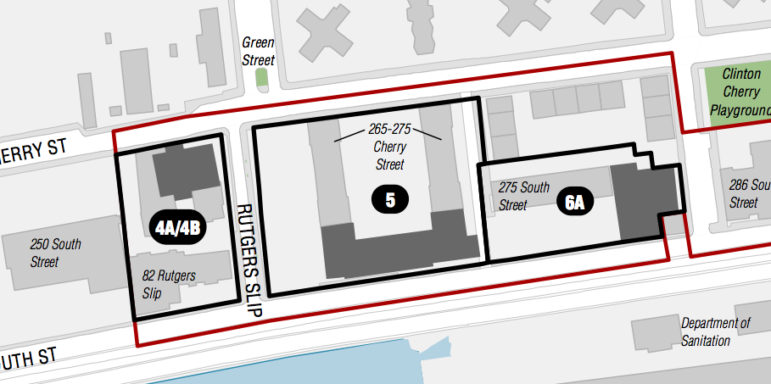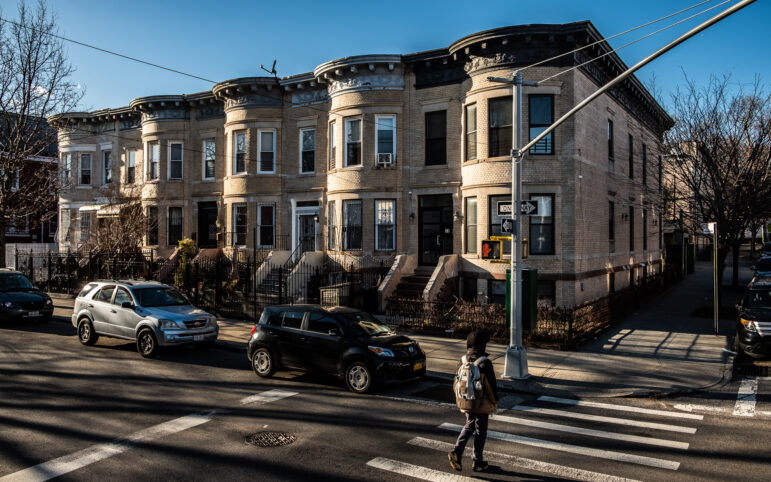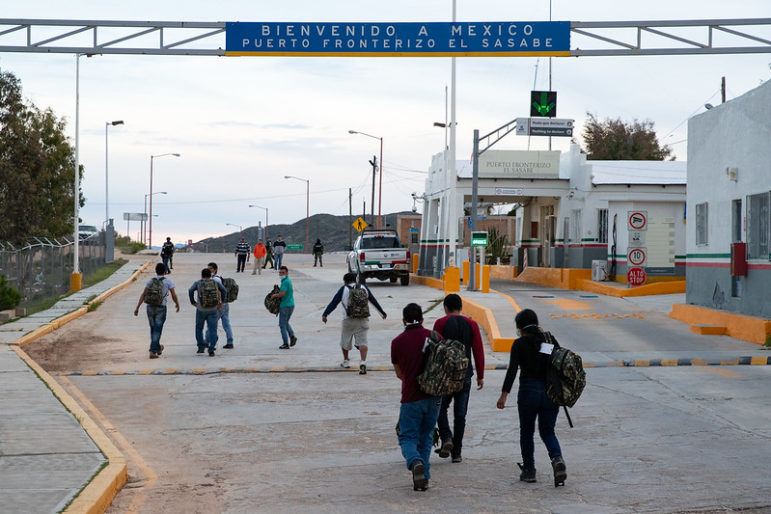
DCP
A Department of City Planning map identifies some of the towers planned for the Two Bridges neighborhood: the 79-story 247 Cherry Street (4A/4B), the 62- and 69-story towers at 260 South Street (5) and the 62-story 259 Clinton Street (6A).
For almost a decade, stakeholders in Chinatown and the Lower East Side have struggled to pass a rezoning to protect the historic character of their neighborhoods and prevent the displacement of existing residents by rising rents. The Chinatown Working Group plan, which received endorsement from Community Board 3 and other groups, encountered objections from the Department of City Planning (DCP) as too expansive and anti-growth.
This winter, however, Community Board 3 accepted DCP’s offer to discuss a potential “Chinatown” rezoning—with the support of Councilmember Margaret Chin, who sees the compromise as a way to move forward. Though no one has yet defined the borders of the potential rezoning, the announcement infuriated members of an alliance called the Coalition to Protect Chinatown and the Lower East Side, who say their leaders are pitting Chinatown’s interests against those of the Black and Latino Lower East Side.
Yet in recent months that discussion has been overshadowed by another, ironically related matter—a development boom of luxury towers on the Lower East Side waterfront, also known as Two Bridges. The Chinatown Working Group’s plan, had it passed, would have instituted height caps and stringent affordability requirements in that area.
In addition to Extell Development Company’s 800 foot (79 story) luxury condominium already rising on South Street, there are plans for four more luxury towers, all between roughly 700 and 1000 feet and within a two-block radius. Extell, the tower already under construction, was grandfathered in under the old 421-a program, and will provide below-market units in a separate building. Each of the three new developers of the four towers has voluntarily offered to rent a quarter of units at below-market rates, likely with the help of the recently renewed 421-a tax credit. One of the developers, Two Bridges Associates LP, has said the affordable units are contingent upon the receipt of the tax credit, but they have also bought a neighboring project Section 8 development and extended the regulatory agreement there for 40 years.
“We hope that this project strengthens the vibrant, mixed-income community in Two Bridges while creating greener, more inviting open spaces, neighborhood-format retail, and up to 338 new units of permanent affordable housing,” a spokesperson for Two Bridges Associates LP wrote in an e-mail to City Limits. “Additionally, important resiliency measures, an improved community room and upgraded outdoor spaces for residents of 265-275 Cherry Street will be made possible by this project. We appreciate the time and energy neighborhood residents have devoted to attending the planning workshops and public meetings so far and look forward to a continued and productive dialogue with the community.”
Last year, Chin pressed the city to require a full public review process for the four planned towers. Though she did not succeed—the developers only need minor changes to the existing land-use regulations in the area, nothing warranting a full public review, the city says—DCP brokered an agreement with the developers to participate in an extended engagement process. The developers are holding four extra community meetings, while a task force of neighborhood stakeholders lead by Chin and Borough President Gale Brewer will seek to represent community concerns.
The process will also include the customary public hearings on the Draft Scope of Work, a document outlining the methods used to conduct the environmental review, and the Environmental Impact Statement, a document that will detail the potential effects of the towers on neighborhood gentrification, local schools, transit and other factors. There will also be a community board hearing.
“The Two Bridges community self-describes as a relatively quiet, under the radar place that up until now was not the subject of a high degree of development, gentrification, secondary displacement and now they are—they’re in the crosshairs of that,” says Jamie Rogers, chair of community board 3. “The most important goal for the community board is to make sure we leave no stone unturned in terms of the different areas of scope that the city must examine.”
Ultimately, the City Planning Commission (CPC) can require the developers to implement mitigation strategies to combat harmful impacts. Chin and Brewer have also succeeded in pushing the first public hearing to May to provide stakeholders with more time to understand the issues. After they pushed the de Blasio administration to publish several important documents, including the Draft Scope of Work, into both Spanish and Chinese, the administration translated one of the shorter documents–the Notice of Scoping, which provides information about the time of the hearing, into both languages.*
“The Two Bridges community needs time to consider all of the impacts of these massive development projects, and that requires the release of information in a language that they can understand,” said Chin in a statement. “That is why I joined Borough President Brewer to fight for more time for the community to arrive at a consensus about its needs and desired outcomes. In order to achieve this goal, I will continue to fight to ensure that residents and business owners in Two Bridges are heard.”
Over the past half century, development in Two Bridges was governed by the rules of the Two Bridges Urban Renewal Area (URA), created in the 1960s with the ambitious goals of promoting the development of mixed-income, racially integrated housing. It is unclear whether the expiration of the URA in 2007 has in some ways changed what can be built there, but Chin recently introduced legislation to ensure that in the future, the city must notify relevant stakeholders when a URA is expiring.
The area is still, however, governed by the rules of a Large Scale Residential Development Special Permit. Under this regulation, the CPC is only allowed to grant the modifications needed by the developers if certain special requirements are met, such as that the changes would benefit both the building’s residents and the city as a whole and not increase density to the detriment of nearby blocks.
Current residents of the area have already expressed concerns about gentrification, shadows and blocked views, worsened air quality due to the construction, taxed public infrastructure, loss of parking and even building safety. Last year, the Department of Buildings issued a partial stop work order to Extell after construction caused cracks and shifts in 82 Rutgers, the affordable apartment building next door.
“In the end, they’ll just rubberstamp. [They’ll claim] all these people came to the meetings and the public was okay with it. But the public is not okay with it,” says Antonio QueyLin, a resident of that building, who is deeply skeptical of the environmental review process.
The Coalition to Protect Chinatown and the Lower East Side see the projects as a win for developers at the expense of the community, one that could have been prevented if Chin had supported the Chinatown Working Group’s plan, and they are organizing a protest calling for her resignation on April 26.
“Ultimately if the Chinatown Working Group plan isn’t passed, if these towers on the waterfront aren’t stopped, that whole Two Bridges neighborhood will just be an extension of Wall Street,” says David Tieu, an organizer with the Coalition.
A representative for Chin said that she supports many of the goal of the Chinatown Working Group plan, but that the de Blasio administration has repeatedly communicated that it needs a more targeted plan, and Chin desires to move forward with a realistic solution.
Meanwhile, Victor Papa, president of the Two Bridges Neighborhood Council, which co-developed much of the affordable housing in the Two Bridges area, sees potential benefits to the towers. His organization sold development rights to JDS Development Group in exchange for much-needed funds for repairs and flood-proofing at their senior building. Papa also says that the environmental review process will likely lead to needed investments in transit and other neighborhood amenities, including a grocery store to replace the Pathmark demolished by Extell.
And what of the long awaited neighborhood rezoning? In time, it’s likely that the community board will take the lead on bringing together stakeholders to discuss a rezoning plan for Chinatown. Deciding how to define the borders of Chinatown may be contentious, with some stakeholders likely to push for borders that include parts of the Lower East Side waterfront that have not yet been grabbed for development.
There will likely be continued discussions on how much to focus on preservation through height limits and whether to promote residential growth—the Chinatown Partnership Local Development Corporation argues Chinatown needs more housing for its residents. And the board is also preparing to undertake a separate but related study on the potential implications of private housing development on NYCHA land, also known as infill development, which was another concern of the Chinatown Working Group’s plan.
The Draft Scope of Work for the Two Bridges developments can be viewed here. The Notice of Scoping can be viewed here in English, Spanish, Chinese Simplified, and Chinese traditional. Two public hearings on the Two Bridges Draft Scope of Work will be held on Thursday May 25, one at 2 pm and another at 6 pm at the Manhattan Municipal Building, Mezzanine level, 1 Centre Street. Written comments on the scope will be accepted until June 8 at 5 pm by writing to Environmental Assessment and Review Division of the Department of City Planning, Attn: Robert Dobruskin, 120 Broadway 31st Floor, New York, NY 10271 , by e-mailing RDOBRUS@planning.nyc.gov or by calling 212-720-3423.
Community Bard 3 will also host a Land Use Committee Meeting to discuss the scope and the Chinatown rezoning study on April 19, 2017, 6:30 pm at the University Settlement at Houston Street Center, 273 Bowery.
*Correction: City Limits originally said that the administration had translated the Draft Scope of Work into both Chinese and Spanish. In fact, it translated the Notice of Scoping into those languages.








